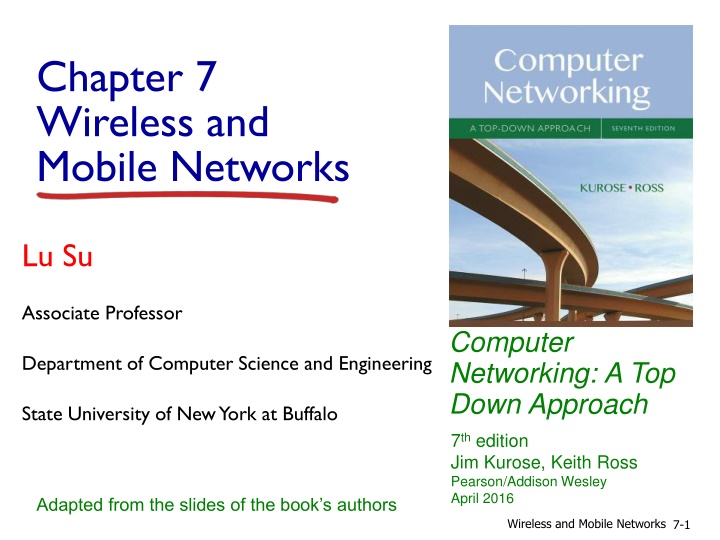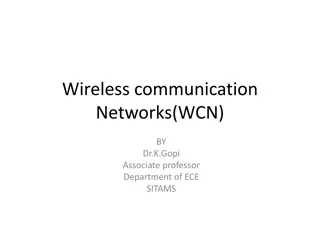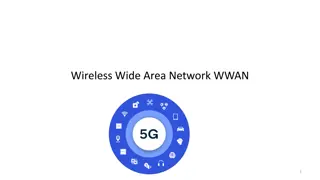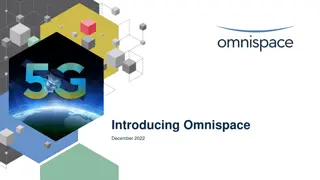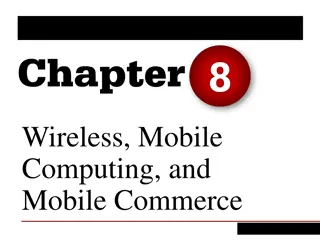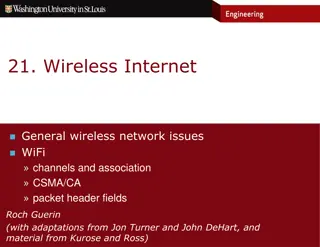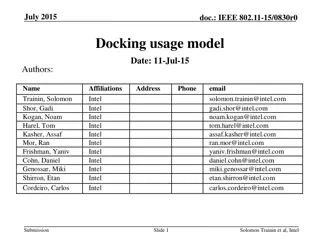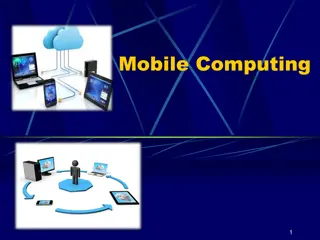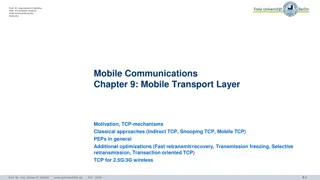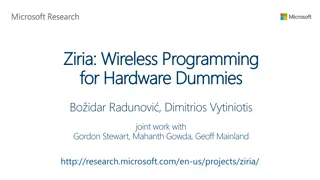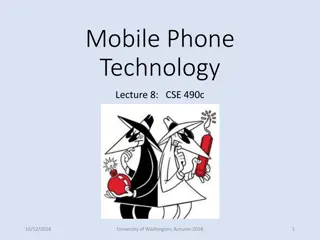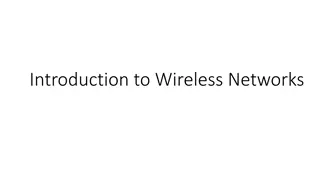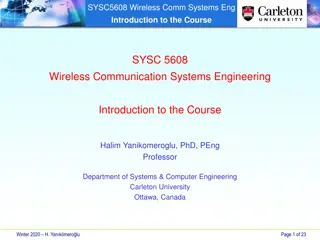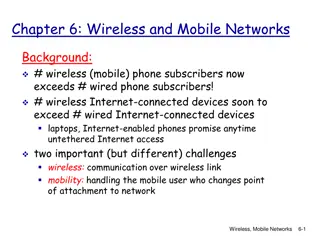Wireless and Mobile Networks Overview
Concepts of mobility, home and visited networks, addressing, and routing in wireless and mobile networks. Understand the vocabulary and approaches for handling mobility in cellular and Wi-Fi networks.
Download Presentation

Please find below an Image/Link to download the presentation.
The content on the website is provided AS IS for your information and personal use only. It may not be sold, licensed, or shared on other websites without obtaining consent from the author.If you encounter any issues during the download, it is possible that the publisher has removed the file from their server.
You are allowed to download the files provided on this website for personal or commercial use, subject to the condition that they are used lawfully. All files are the property of their respective owners.
The content on the website is provided AS IS for your information and personal use only. It may not be sold, licensed, or shared on other websites without obtaining consent from the author.
E N D
Presentation Transcript
Chapter 7 Wireless and Mobile Networks Lu Su Associate Professor Computer Networking: A Top Down Approach Department of Computer Science and Engineering State University of New York at Buffalo 7th edition Jim Kurose, Keith Ross Pearson/Addison Wesley April 2016 Adapted from the slides of the book s authors Wireless and Mobile Networks 7-1
Chapter 7 outline 7.1 Introduction Wireless 7.2 Wireless links, characteristics CDMA 7.3 IEEE 802.11 wireless LANs ( Wi-Fi ) 7.4 Cellular Internet Access architecture standards (e.g., 3G, LTE) Mobility 7.5 Principles: addressing and routing to mobile users 7.6 Mobile IP 7.7 Handling mobility in cellular networks 7.8 Mobility and higher-layer protocols Wireless and Mobile Networks 7-2
What is mobility? spectrum of mobility, from the network perspective: no mobility high mobility mobile wireless user, using same access point mobile user, passing through multiple access point while maintaining ongoing connections (like cell phone) mobile user, connecting/ disconnecting from network using DHCP. Wireless and Mobile Networks 7-3
Mobility: vocabulary home network: permanent home of mobile (e.g., 128.119.40/24) home agent: entity that will perform mobility functions on behalf of mobile, when mobile is remote wide area network permanent address: address in home network, can always be used to reach mobile e.g., 128.119.40.186 Wireless and Mobile Networks 7-4
Mobility: more vocabulary visited network: network in which mobile currently resides (e.g., 79.129.13/24) permanent address: remains constant (e.g., 128.119.40.186) care-of-address: address in visited network. (e.g., 79,129.13.2) wide area network foreign agent: entity in visited network that performs mobility functions on behalf of mobile. correspondent: wants to communicate with mobile Wireless and Mobile Networks 7-5
How do you contact a mobile friend: Consider friend frequently changing addresses, how do you find her? I wonder where Alice moved to? search all phone books? call her parents? expect her to let you know where he/she is? Facebook! Wireless and Mobile Networks 7-6
Mobility: approaches let routing handle it: routers advertise permanent address of mobile-nodes-in-residence via usual routing table exchange. routing tables indicate where each mobile located no changes to end-systems let end-systems handle it: indirect routing: communication from correspondent to mobile goes through home agent, then forwarded to remote direct routing: correspondent gets foreign address of mobile, sends directly to mobile Wireless and Mobile Networks 7-7
Mobility: approaches let routing handle it: routers advertise permanent address of mobile-nodes-in-residence via usual routing table exchange. routing tables indicate where each mobile located no changes to end-systems let end-systems handle it: indirect routing: communication from correspondent to mobile goes through home agent, then forwarded to remote direct routing: correspondent gets foreign address of mobile, sends directly to mobile not scalable to millions of mobiles Wireless and Mobile Networks 7-8
Mobility: registration visited network home network 1 2 wide area network mobile contacts foreign agent on entering visited network foreign agent contacts home agent home: this mobile is resident in my network end result: foreign agent knows about mobile home agent knows location of mobile Wireless and Mobile Networks 7-9
Mobility via indirect routing foreign agent receives packets, forwards to mobile home agent intercepts packets, forwards to foreign agent visited network home network 3 wide area network 2 1 4 correspondent addresses packets using home address of mobile mobile replies directly to correspondent Wireless and Mobile Networks 7-10
Indirect Routing: comments mobile uses two addresses: permanent address: used by correspondent (hence mobile location is transparent to correspondent) care-of-address: used by home agent to forward datagrams to mobile foreign agent functions may be done by mobile itself triangle routing: correspondent-home-network- mobile inefficient when correspondent, mobile are in same network Wireless and Mobile Networks 7-11
Indirect routing: moving between networks suppose mobile user moves to another network registers with new foreign agent new foreign agent registers with home agent home agent update care-of-address for mobile packets continue to be forwarded to mobile (but with new care-of-address) mobility, changing foreign networks transparent: on going connections can be maintained! Wireless and Mobile Networks 7-12
Mobility via direct routing foreign agent receives packets, forwards to mobile correspondent forwards to foreign agent visited network home network 3 2 1 4 mobile replies directly to correspondent correspondent requests, receives foreign address of mobile Wireless and Mobile Networks 7-13
Mobility via direct routing: comments overcome triangle routing problem non-transparent to correspondent: correspondent must get care-of-address from home agent what if mobile changes visited network? 3 2 1 4 Wireless and Mobile Networks 7-14
Accommodating mobility with direct routing anchor foreign agent: FA in first visited network data always routed first to anchor FA when mobile moves: new FA arranges to have data forwarded from old FA (chaining) foreign net visited at session start anchor foreign agent wide area network 2 1 4 3 5 new foreign network correspondent agent new foreign agent correspondent Wireless and Mobile Networks 7-15
Chapter 7 outline 7.1 Introduction Wireless 7.2 Wireless links, characteristics CDMA 7.3 IEEE 802.11 wireless LANs ( Wi-Fi ) 7.4 Cellular Internet Access architecture standards (e.g., 3G, LTE) Mobility 7.5 Principles: addressing and routing to mobile users 7.6 Mobile IP 7.7 Handling mobility in cellular networks 7.8 Mobility and higher-layer protocols Wireless and Mobile Networks 7-16
Mobile IP RFC 3344 has many features we ve seen: home agents, foreign agents, foreign-agent registration, care-of-addresses, encapsulation (packet-within-a- packet) three components to standard: indirect routing of datagrams agent discovery registration with home agent Wireless and Mobile Networks 7-17
Mobile IP: indirect routing foreign-agent-to-mobile packet packet sent by home agent to foreign agent: a packet within a packet dest: 128.119.40.186 dest: 79.129.13.2 dest: 128.119.40.186 Permanent address: 128.119.40.186 Care-of address: 79.129.13.2 dest: 128.119.40.186 packet sent by correspondent Wireless and Mobile Networks 7-18
Mobile IP: agent discovery agent advertisement: foreign/home agents advertise service by broadcasting ICMP messages (typefield = 9) 16 0 8 24 type = 9 checksum code = 0 H,F bits: home and/or foreign agent standard ICMP fields router address R bit: registration required type = 16 length sequence # RBHFMGV bits registration lifetime reserved mobility agent advertisement extension 0 or more care-of- addresses Wireless and Mobile Networks 7-19
Mobile IP: registration example visited network: 79.129.13/24 foreign agent COA: 79.129.13.2 home agent HA: 128.119.40.7 mobile agent MA: 128.119.40.186 ICMP agent adv. COA: 79.129.13.2 . registration req. registration req. COA: 79.129.13.2 HA: 128.119.40.7 MA: 128.119.40.186 Lifetime: 9999 identification:714 . COA: 79.129.13.2 HA: 128.119.40.7 MA: 128.119.40.186 Lifetime: 9999 identification: 714 encapsulation format . registration reply HA: 128.119.40.7 MA: 128.119.40.186 Lifetime: 4999 Identification: 714 encapsulation format . registration reply HA: 128.119.40.7 MA: 128.119.40.186 Lifetime: 4999 Identification: 714 . time Wireless and Mobile Networks 7-20
Chapter 7 summary Wireless wireless links: capacity, distance channel impairments CDMA IEEE 802.11 ( Wi-Fi ) CSMA/CA reflects wireless channel characteristics cellular access architecture standards (e.g., 3G, 4G LTE) Mobility principles: addressing, routing to mobile users home, visited networks direct, indirect routing care-of-addresses case studies mobile IP mobility in GSM, LTE impact on higher-layer protocols Wireless and Mobile Networks 7-21
